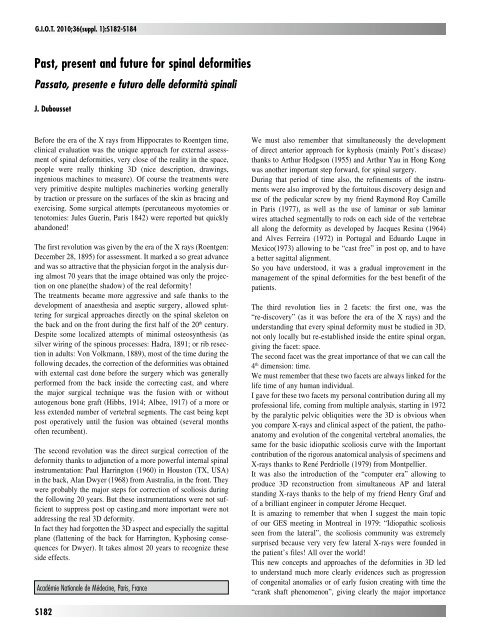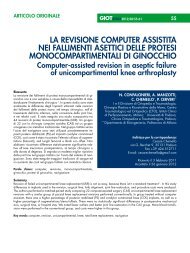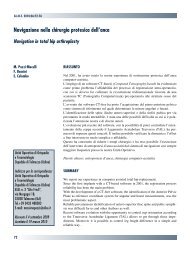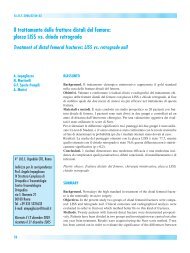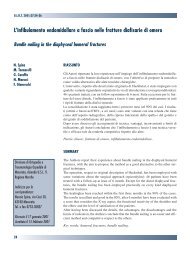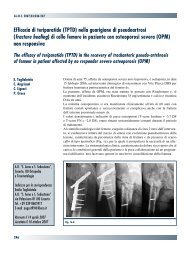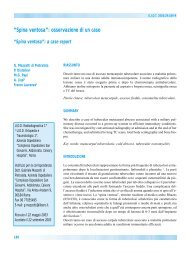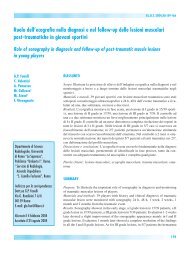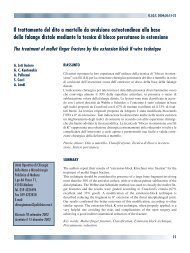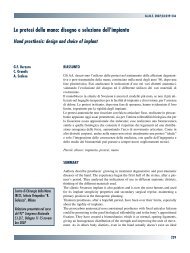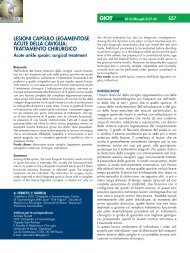30845 Suppl Giot.pdf - Giornale Italiano di Ortopedia e Traumatologia
30845 Suppl Giot.pdf - Giornale Italiano di Ortopedia e Traumatologia
30845 Suppl Giot.pdf - Giornale Italiano di Ortopedia e Traumatologia
You also want an ePaper? Increase the reach of your titles
YUMPU automatically turns print PDFs into web optimized ePapers that Google loves.
G.I.O.T. 2010;36(suppl. 1):S182-S184<br />
Past, present and future for spinal deformities<br />
Passato, presente e futuro delle deformità spinali<br />
J. Dubousset<br />
Before the era of the X rays from Hippocrates to Roentgen time,<br />
clinical evaluation was the unique approach for external assessment<br />
of spinal deformities, very close of the reality in the space,<br />
people were really thinking 3D (nice description, drawings,<br />
ingenious machines to measure). Of course the treatments were<br />
very primitive despite multiples machineries working generally<br />
by traction or pressure on the surfaces of the skin as bracing and<br />
exercising. Some surgical attempts (percutaneous myotomies or<br />
tenotomies: Jules Guerin, Paris 1842) were reported but quickly<br />
abandoned!<br />
The first revolution was given by the era of the X rays (Roentgen:<br />
December 28, 1895) for assessment. It marked a so great advance<br />
and was so attractive that the physician forgot in the analysis during<br />
almost 70 years that the image obtained was only the projection<br />
on one plane(the shadow) of the real deformity!<br />
The treatments became more aggressive and safe thanks to the<br />
development of anaesthesia and aseptic surgery, allowed spluttering<br />
for surgical approaches <strong>di</strong>rectly on the spinal skeleton on<br />
the back and on the front during the first half of the 20 th century.<br />
Despite some localized attempts of minimal osteosynthesis (as<br />
silver wiring of the spinous processes: Hadra, 1891; or rib resection<br />
in adults: Von Volkmann, 1889), most of the time during the<br />
following decades, the correction of the deformities was obtained<br />
with external cast done before the surgery which was generally<br />
performed from the back inside the correcting cast, and where<br />
the major surgical technique was the fusion with or without<br />
autogenous bone graft (Hibbs, 1914; Albee, 1917) of a more or<br />
less extended number of vertebral segments. The cast being kept<br />
post operatively until the fusion was obtained (several months<br />
often recumbent).<br />
The second revolution was the <strong>di</strong>rect surgical correction of the<br />
deformity thanks to adjunction of a more powerful internal spinal<br />
instrumentation: Paul Harrington (1960) in Houston (TX, USA)<br />
in the back, Alan Dwyer (1968) from Australia, in the front. They<br />
were probably the major steps for correction of scoliosis during<br />
the following 20 years. But these instrumentations were not sufficient<br />
to suppress post op casting,and more important were not<br />
addressing the real 3D deformity.<br />
In fact they had forgotten the 3D aspect and especially the sagittal<br />
plane (flattening of the back for Harrington, Kyphosing consequences<br />
for Dwyer). It takes almost 20 years to recognize these<br />
side effects.<br />
Académie Nationale de Médecine, Paris, France<br />
S182<br />
We must also remember that simultaneously the development<br />
of <strong>di</strong>rect anterior approach for kyphosis (mainly Pott’s <strong>di</strong>sease)<br />
thanks to Arthur Hodgson (1955) and Arthur Yau in Hong Kong<br />
was another important step forward, for spinal surgery.<br />
During that period of time also, the refinements of the instruments<br />
were also improved by the fortuitous <strong>di</strong>scovery design and<br />
use of the pe<strong>di</strong>cular screw by my friend Raymond Roy Camille<br />
in Paris (1977), as well as the use of laminar or sub laminar<br />
wires attached segmentally to rods on each side of the vertebrae<br />
all along the deformity as developed by Jacques Resina (1964)<br />
and Alves Ferreira (1972) in Portugal and Eduardo Luque in<br />
Mexico(1973) allowing to be “cast free” in post op, and to have<br />
a better sagittal alignment.<br />
So you have understood, it was a gradual improvement in the<br />
management of the spinal deformities for the best benefit of the<br />
patients.<br />
The third revolution lies in 2 facets: the first one, was the<br />
“re-<strong>di</strong>scovery” (as it was before the era of the X rays) and the<br />
understan<strong>di</strong>ng that every spinal deformity must be stu<strong>di</strong>ed in 3D,<br />
not only locally but re-established inside the entire spinal organ,<br />
giving the facet: space.<br />
The second facet was the great importance of that we can call the<br />
4 th <strong>di</strong>mension: time.<br />
We must remember that these two facets are always linked for the<br />
life time of any human in<strong>di</strong>vidual.<br />
I gave for these two facets my personal contribution during all my<br />
professional life, coming from multiple analysis, starting in 1972<br />
by the paralytic pelvic obliquities were the 3D is obvious when<br />
you compare X-rays and clinical aspect of the patient, the pathoanatomy<br />
and evolution of the congenital vertebral anomalies, the<br />
same for the basic i<strong>di</strong>opathic scoliosis curve with the Important<br />
contribution of the rigorous anatomical analysis of specimens and<br />
X-rays thanks to René Perdriolle (1979) from Montpellier.<br />
It was also the introduction of the “computer era” allowing to<br />
produce 3D reconstruction from simultaneous AP and lateral<br />
stan<strong>di</strong>ng X-rays thanks to the help of my friend Henry Graf and<br />
of a brilliant engineer in computer Jérome Hecquet.<br />
It is amazing to remember that when I suggest the main topic<br />
of our GES meeting in Montreal in 1979: “I<strong>di</strong>opathic scoliosis<br />
seen from the lateral”, the scoliosis community was extremely<br />
surprised because very very few lateral X-rays were founded in<br />
the patient’s files! All over the world!<br />
This new concepts and approaches of the deformities in 3D led<br />
to understand much more clearly evidences such as progression<br />
of congenital anomalies or of early fusion creating with time the<br />
“crank shaft phenomenon”, giving clearly the major importance


